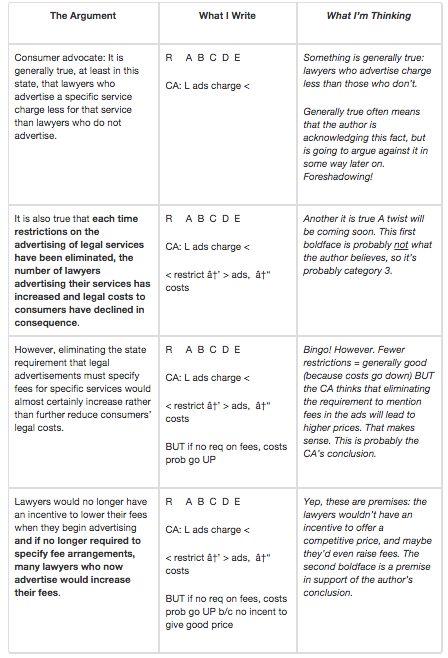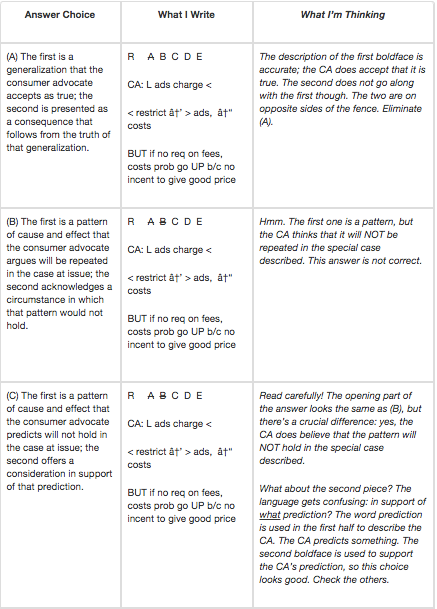Analyzing a Critical Reasoning Boldface Question
- Form the Manhattan GMAT BlogTry this problem out! Give yourself about 2 minutes (though it’s okay to stretch to 2.5 minutes on a long one like this as long as you are making progress.)
Consumer advocate: It is generally true, at least in this state, that lawyers who advertise a specific service charge less for that service than lawyers who do not advertise. It is also true that
each time restrictions on the advertising of legal services have been eliminated, the number of lawyers advertising their services has increased and legal costs to consumers have declined in consequence. However, eliminating the state requirement that legal advertisements must specify fees for specific services would almost certainly increase rather than further reduce consumers’ legal costs. Lawyers would no longer have an incentive to lower their fees when they begin advertising
and if no longer required to specify fee arrangements, many lawyers who now advertise would increase their fees.
In the consumer advocate’s argument, the two portions in boldface play which of the following roles?
(A) The first is a generalization that the consumer advocate accepts as true; the second is presented as a consequence that follows from the truth of that generalization.
(B) The first is a pattern of cause and effect that the consumer advocate argues will be repeated in the case at issue; the second acknowledges a circumstance in which that pattern would not hold.
(C) The first is a pattern of cause and effect that the consumer advocate predicts will not hold in the case at issue; the second offers a consideration in support of that prediction.
(D) The first is evidence that the consumer advocate offers in support of a certain prediction; the second is that prediction.
(E) The first acknowledges a consideration that weighs against the main position that the consumer advocate defends; the second is that position.
Step 1: Identify the Question
The argument itself contains the most common clue for a Describe the Role question: boldface font in the text. This clue doesn’t always exist but it is usually there. The question stem also signals the type by asking for the role played by the two portions in boldface.
Step 2: Deconstruct the Argument
All right, this is a Role question. The argument will contain a conclusion, and the boldface portions will relate to the conclusion in one of three broad ways:
The boldface text could be the conclusion.
The boldface text could support the conclusion.
The boldface text could be anything else (including neutral background), though most commonly it will be either counter-premise or a counter-conclusion.
Here’s what I thought and wrote while I did the problem. Your own thought process won’t be exactly the same as mine and, of course, your notes will probably look quite different, since we all have our own ways of abbreviating things. (Note: R = Describe the Role)

Step 3: State the Goal
This is a Role question, so I have to figure out what roles the two boldface statements play.
The first one does NOT go along with the CA’s argument, so it must be category 3. The information is interesting: the CA acknowledges that it is generally true, but just doesn’t think that it applies to one specific circumstance.
The second boldface supports the CA’s conclusion.
Work from Wrong to Right

 The correct answer is (C).
The correct answer is (C).
Note that the language of the answer choices is very confusing. Try to keep the three main categories in mind: (1) it IS the conclusion, (2) it SUPPORTS the conclusion, (3) it’s anything other than 1 or 2. That classification will make it easier to get rid of some answer choices, even if you don’t fully follow the convoluted language.
Take-aways for CR Role questions:
(1) The question stem will usually include the word role and will almost always (but not always!) include bold font in the argument.
(2) Once you realize you have a Role question, classify the boldface font into one of the three categories discussed above.
(3) If you struggle to understand what a choice says, ask yourself whether the language most likely goes with category 1, 2, or 3. That might be enough to help you eliminate the answer.
Attachment:
 00000325.png [ 145.5 KiB | Viewed 5414 times ]
00000325.png [ 145.5 KiB | Viewed 5414 times ]
Attachment:
 00000326.png [ 129.92 KiB | Viewed 5414 times ]
00000326.png [ 129.92 KiB | Viewed 5414 times ]



 85%
(hard)
85%
(hard)
 45%
(02:49)
wrong
45%
(02:49)
wrong  based on 5021
sessions
based on 5021
sessions





















